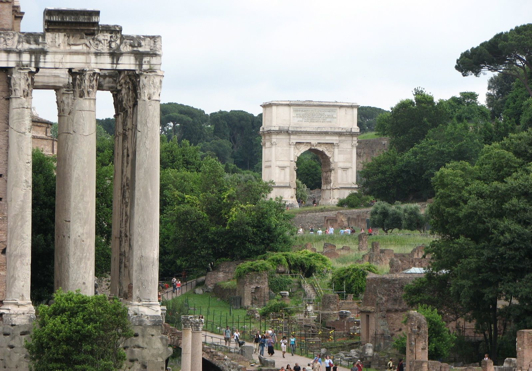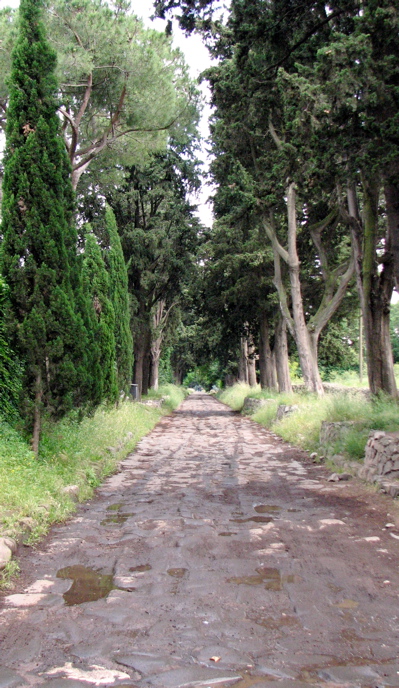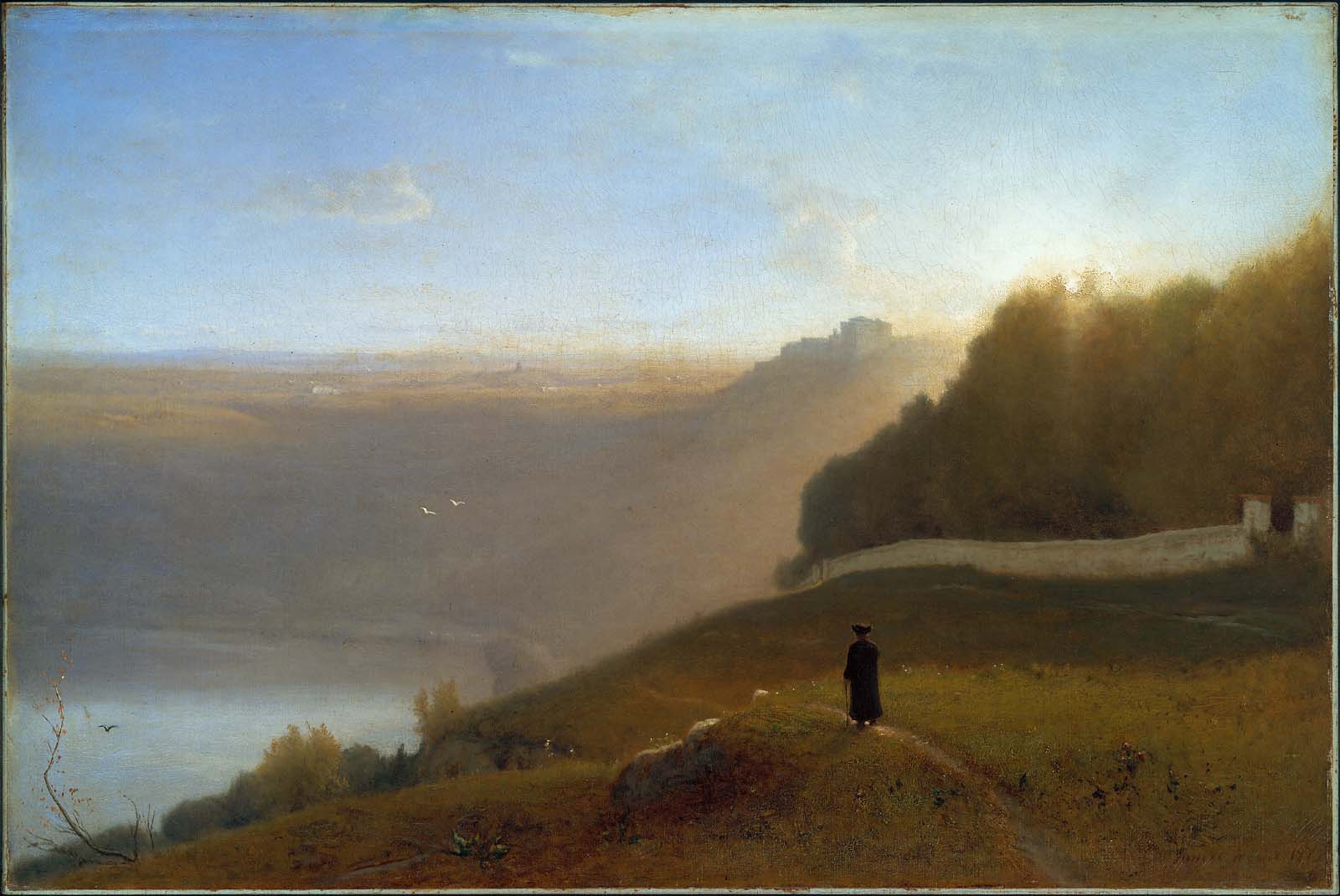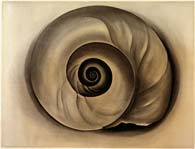Instructive imagery
"In the Arician vale there is a lake begirt by shady woods and hallowed by religion of old."
Ovid, "Book of Days".
George Inness painted this historically significant lake in 1872 after Joseph Mallord William Turner, among other painters, had created the scene as the iconic " The Golden Bough" by his 1834 painting. What can be understood here by an analysis of the paintings, the setting, and expository literary sources is how layered is the history of this place.
George Inness, Lake Nemi, 1872. American in Rome, 1825–1894. Boston Museum of Fine Arts.
"Inness depicted Lake Nemi in at least nine paintings, including another work link in the Museum’s collection, which he made during a subsequent visit to the area in about 1874."
The Golden Bough
"No one who has seen the calm water of the Lake of Nemi, lapped in a green hollow of the Alban Hills, can ever forget it. Diana herself might still be lingering by this lonely shore, haunting these woodlands wild. In antiquity this sylvan landscape was the scene of a strange and recurring tragedy. On the northern shore of the lake stood a sacred grove of Diana Nemorensis – that is Diana of the Woodland Glade. The lake and the grove were sometimes known as the lake and grove of Aricia. In that grove grew a certain tree round which, at any hour of the day and probably far into the night, a grim figure might be seen to prowl. In his hand he carried a drawn sword, and he kept peering warily about him as if at any instant he expected to be set upon."
Sir James George Frazer, The New Golden Bough, (1890); p. 31.
Commentary.
The imagery of a "lonely shore" on the north side of the lake is the ruins of the Temple of Diana, a cult worship site from Roman times. The cult may actually be of Greek derivation from the period of the Hellenic colonization of Italy and thus entailed with the veneration of Artemis and her associated groves a widespread practice throughout the Eastern Mediterranean before Christianity.
Method
This is a comparative approach with the effect of discerning informative differences between what we see and what we know and among what we are told, what has been found, and what endures.
- The story is deeper than it initially appears.
- The influence of the story of this place is very widespread. (For example Frazer influenced Sigmund Freud's 1913, Totem and Taboo.)
- Literature, art, and archaeology are the three dimensions that reveal a depth of field required to comprehend the past. The appropriate depth is derived from the stereoscopic viewpoint of this comparative method. In this way the August ceremony to the Goddess Diana takes on an ever more profound importance.
Logic placement
The feast may be as old or older than Virgil's story.
The feast of the Nemoralia dedicated to Artemis / Diana was celebrated with torches during the full
moon of August, traditionally between 13-15 of the month to honor the wood of Aricia. Ovid and Plutarch both reveal the antiquity of the ceremonial events surrounding the annual ritual. This Festival of the Torches was called after nemus, the Latin word for a glade, or grove.
So popular was the pagan feast that the early Church selected the festival of Diana to celebrate the Assumption in honor the Virgin Mary.
Photograph of the statue of Artemis from Ephesus, above.
Nemoralia
The story wherein the golden bough appears in Virgil's Aeneid, the Roman epic poem where Aeneas must fetch the limb of a tree in a sacred grove. There is a parallel story associated with the cult of Artemis, called Diana in the Latin by the Romans. The story excited the imagination of artists upon seeing the landscape associated with the grove beside the lake.
As early as 1798 Turner painted the Sibyl Cumae with Aeneas as inspired by Virgil's poetry of this hero's attempt to visit the ghost of his father in the Underworld.
Turner's 1834 painting of The Golden Bough, is said to have inspired Sir James Frazer and he by his book inspired T.S. Eliot's poem "The Wasteland." Here is an example of contingent events.
Chronological order:
The chronology of Lake Nemi reveals that it was from antiquity (BCE or before the common era) a significant geographical feature in the Roman landscape:
Colli Albani [the Alban crater] most recently erupted about 22,000 years ago, forming the craters now filled by the beautiful lakes of Albano and Nemi.
300 BCE a temple of an "Etruscan style" is built to honor rituals associated with the sacred grove.
CE or the common era ( after Christ A.D. )
8, Ovid's "Book of Days" Fasti, book three is dedicated to Mars patron of March – that once had been the first month.
37-41, Caligula's reign as Roman Emperor.
39, Caligula had two huge shipsfloated on Nemi Lake, Caligula's navy as such was dedicated to the Goddess Diana.
1598, A diving bell used to discover ship ruins in Nemi.
1697, John Dryden's translation of the Aeneid.
1748, Claude-Joseph Vernet's painting of Nemi Lake
1777, painting of Lake Nemi by John Robert Cozens
1798 - 1834, Joseph M. W. Turner's paintings of Nemi Lake.
1807, Jacob Philipp Hackert's painting "Lake Nemi from the north . . . "
1872-1874, Inness' paintings of Lake Nemi.
1928-1939, Guido Ucelli's successful retrieval of two ships from the bottom of the lake
Present, The area is still seismically active, as demonstrated again on 12-13 June 1995 when Roma was jolted by a series of earthquakes (up to magnitude 3.9 Richter).
Next
Commentaries
So begins the book by Sir James Frazer with the haunting lines, "He was at once a priest and murderer, and the man for whom he was watching was sooner or later to murder him. . . "
Frazer translated Ovid's Fasti, or Book of Days, and therein read of the Lake of Nemi.
These specialists argue that Frazer's two volumes on the comparative history of myth and religion, from 1890, republished in 1926 and reissued in 1959, may have been misunderstood and not quite accurately conveyed how early people's rituals on which he reported were conducted, interpreted, and laden with significance.
Book Six of the Aeneid, for example, also recites the story of Daedalus and Icarus, in addition to explaining how Aeneas must fetch the golden bough from the sacred tree of the Arician grove beside the Nemi Lake.
Background
By nature, if you divide the world into that which is substantially altered by human intervention and that which is less so influences the categories emerge separating the natural from the artificial. If you think in these dichotomous terms, you have used Aristotle's two vast categories in a taxonomy of ancient origins and enduring power to influence the mind.
Equally significant as this taxonomy are the consequences of comprehending nature. Specifically the capacity of nature's seasonal, annual or chronic capacity for renewal coaxed a series of explanations to surface about what sources of this ability to regenerate must persist. Beneath the characteristic generative capability of nature must lie some enduring process; a cause for this apparently unending cycle of vegetation to grow, mature, die and return to vigor as newly sprouting seedlings. Following drought, or fire, or flood what was apparent to even pre agricultural humans was this occult power to come back from the dead, the barren and the senescent states of existence. Simply summarized: nature dies and then is seemingly reborn.
Resurrection and return are thus a profoundly old theme.
Textually speaking: Virgil influenced Dryden as Ovid influenced Frazer as the artists conveyed the evocative scene to writers.
Dryden's translation of a part of Book Six of the Aeneid:
Thus, from the dark recess, the Sibyl spoke,
And the resisting air the thunder broke;
The cave rebellow'd, and the temple shook.
Th' ambiguous god, who rul'd her lab'ring breast,
In these mysterious words his mind express'd;
Some truths reveal'd, in terms involv'd the rest.
At length her fury fell, her foaming ceas'd,
And, ebbing in her soul, the god decreas'd.
Then thus the chief: "No terror to my view,
No frightful face of danger can be new.
Inur'd to suffer, and resolv'd to dare,
The Fates, without my pow'r, shall be without my care.
This let me crave, since near your grove the road
To hell lies open, and the dark abode
Which Acheron surrounds, th' innavigable flood;. . . .
Receive my counsel. In the neighb'ring grove
There stands a tree; the queen of Stygian Jove
Claims it her own; thick woods and gloomy night
Conceal the happy plant from human sight.
One bough it bears; but (wondrous to behold!)
The ductile rind and leaves of radiant gold:
This from the vulgar branches must be torn,
And to fair Proserpine the present borne,
Ere leave be giv'n to tempt the nether skies.
The first thus rent a second will arise,
And the same metal the same room supplies.
Look round the wood, with lifted eyes, to see
The lurking gold upon the fatal tree:
Then rend it off, as holy rites command;
The willing metal will obey thy hand,
Following with ease, if favor'd by thy fate,
Thou art foredoom'd to view the Stygian state:
If not, no labor can the tree constrain;
And strength of stubborn arms and steel are vain.
Besides, you know not, while you here attend,
Th' unworthy fate of your unhappy friend:
Breathless he lies; and his unburied ghost,
Depriv'd of fun'ral rites, pollutes your host.
Pay first his pious dues; and, for the dead,
Two sable sheep around his hearse be led;
Then, living turfs upon his body lay:
This done, securely take the destin'd way,
To find the regions destitute of day."
She said, and held her peace. Aeneas went
Sad from the cave, and full of discontent,
Unknowing whom the sacred Sibyl meant.
Ovid: "Book of Days"
"Inform me, thou nymph who on Diana’s grove and lake dost wait; thou nymph, wife of Numa, come tell of thine own deeds. In the Arician vale there is a lake begirt by shady woods and hallowed by religion of old.28 Here Hippolytus29 lies hid, who by the reins of his steeds was rent in pieces: hence no horses enter that grove. The long fence is draped with hanging threads, and many a tablet there attests the merit of the goddess. Often doth a woman, whose prayer has been answered, carry from the City burning torches, while garlands wreathe her brows. The strong of hand and fleet of foot do there reign kings,30 and each is slain thereafter even as himself has slain. A pebbly brook flows down with fitful murmur; oft have I drunk of it, but in little sips."
. . .
"Numa resolved to soften their fierce temper by force of law and fear of gods. Hence laws were made, that the stronger might not in all things have his way, and rites, handed down from the fathers, began to be piously observed. Men put off savagery, justice was more puissant than arms, citizen thought shame to fight with citizen, and he who but now had shown himself truculent would at the sight of an altar be transformed and offer wine and salted spelt on the warm hearths."
Sources:
Gaster, Theodore, ed. Sir James Frazer. The New Golden Bough, New York: Mentor; Criterion books, 1959.
Ovid, Fasti 3: Translated by James G. Frazer, [Rome: Fasti, or "Book of Days" 8 AD.] verse, 259.
"nympha, mone, nemori stagnoque operata Dianae;
nympha, Numae coniunx, ad tua facta veni.
vallis Aricinae silva praecinctus opaca
est lacus, antiqua religione sacer;"lines 261-264 in LATIN text.
Jones, Jonathan. "Modern Myths: From T. S. Eliot to Apocalypse Now, . . .", The Guardian. Friday, 9 December 2005. retrieved – 05.08.2014 10:29.
Lake Nemi: Diana’s Sacred Grove, by Ludovico Pisani, February 16, 2013: The Global Dispatches, retrieved – 05.08.2014 11:09.
Pisani contends that: "James George Frazer, in his revolutionary work The Golden Bough, made the story of the bloody priesthood famous. He interpreted it as another example of a myth found the world over, which tells of a sacred king who must periodically die and be resurrected, or be replaced, as part of a fertility rite. The book’s title was taken from an incident in the Aeneid, illustrated by the British artist Joseph Turner.
Colli Albani volcano, Italy.
"Until very recently, the Colli Albani has generally been considered an inactive volcano (especially after records of activity in historical sources have been discarded by various researchers, such as Stothers & Rampino 1983). However, new absolute age datings have revealed that volcanic activity occurred as recently as about 22 ka ago which is much younger than any of the other volcanoes of Central Italy. Furthermore, the volcano is seismically active, with several notable earthquake swarms since the early 1980's.
Tate Gallery, London, U.K.
Boston Museum of Fine Arts, U.S.A.
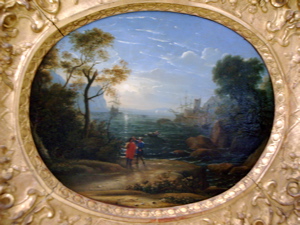
.gif)

